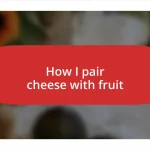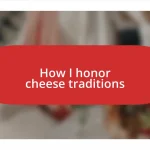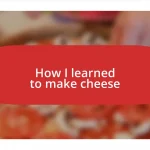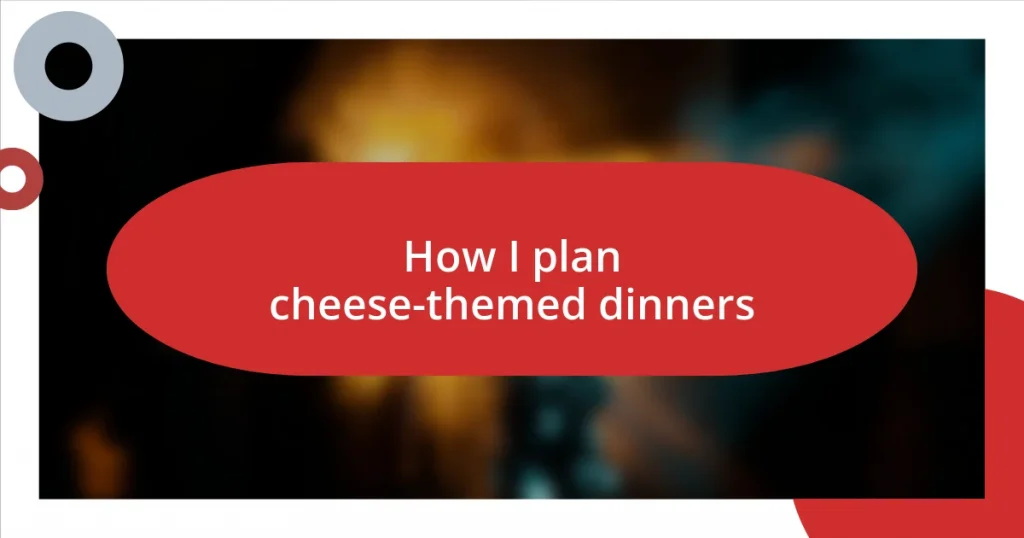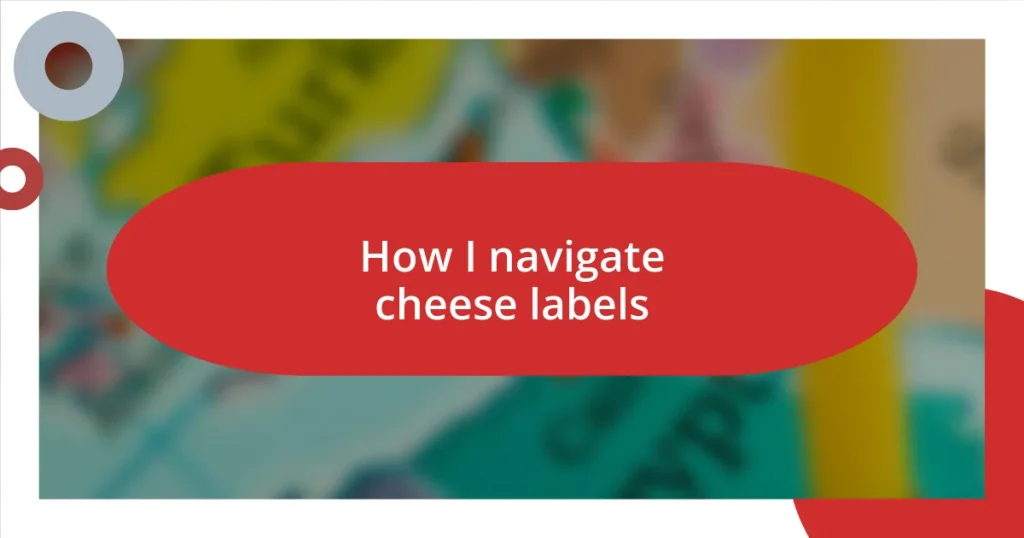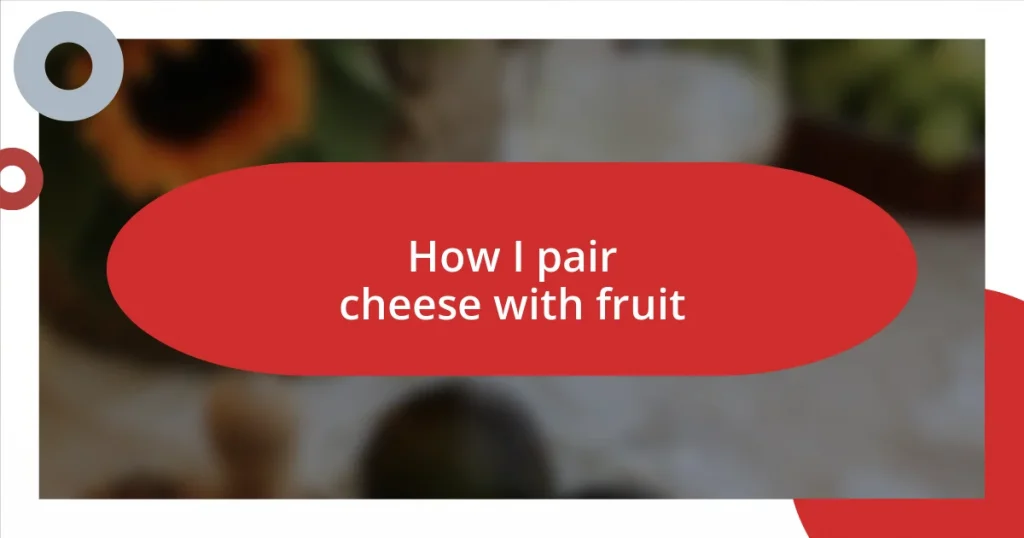Key takeaways:
- Choose cheeses that complement each other in flavor and texture, keeping seasonality in mind to create a cohesive dining experience.
- Select complementary foods and beverages to balance the cheese flavors, enhancing the overall enjoyment of the meal.
- Create the right ambiance with lighting, music, and a well-executed plan to foster a relaxed and inviting atmosphere for shared experiences.
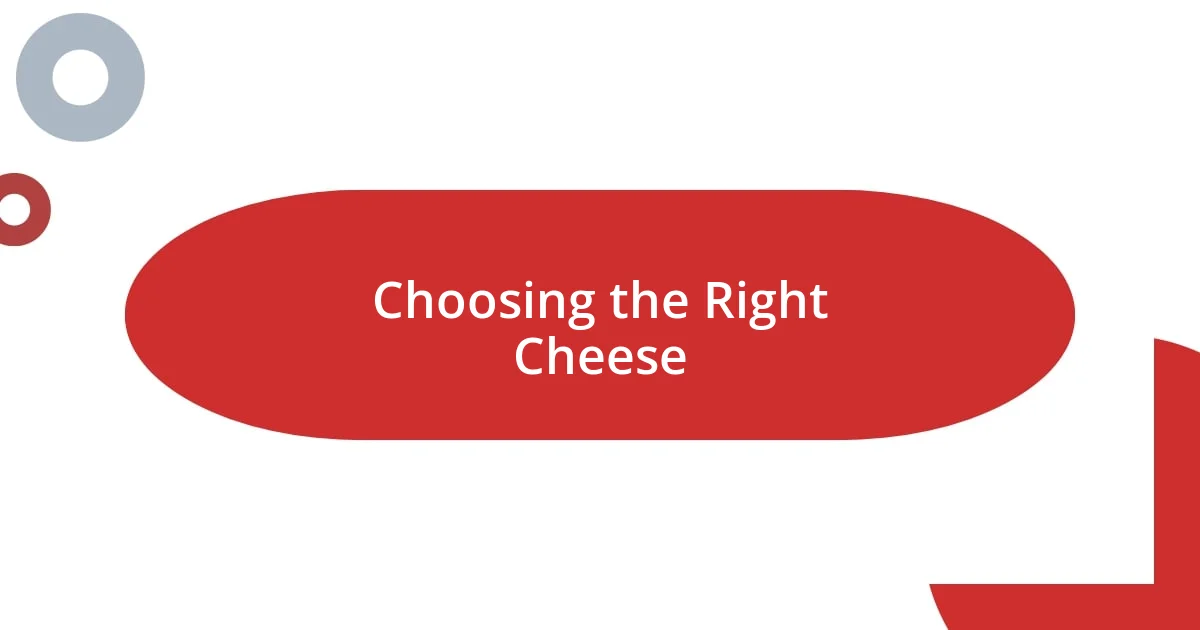
Choosing the Right Cheese
When choosing the right cheese for your dinner, consider the flavor profiles you want to highlight. I remember a dinner party where I decided to showcase a creamy Brie alongside a sharp cheddar; the contrast delighted my guests and sparked lively conversation. Have you ever thought about how cheese can set the mood?
Don’t forget the texture! Softer cheeses like goat cheese can evoke a sense of lightness, while a crumbly blue cheese can add depth and richness. I learned this the hard way when I paired a soft Camembert with overly crunchy crackers—what a mismatch! Each cheese you select should complement the other elements of your meal without overpowering them.
Also, keep in mind the seasonality and occasion. For instance, a robust Parmigiano-Reggiano can be perfect for a winter soiree, evoking warmth and comfort. I find that when I choose cheeses that reflect the season, it brings a certain coherence to the entire meal. Isn’t it satisfying to let your ingredients tell a story?

Selecting Complementary Foods
When selecting complementary foods for your cheese-themed dinner, the key is to think about balance. I once hosted a gathering where I paired a tangy blue cheese with sweet figs and honey. The combination not only heightened the flavors of the cheese but also created a delightful harmony on the palate, sparking joy among my friends. I believe that introducing contrasting elements can elevate the overall dining experience significantly.
Here are some complementary foods you might consider:
- Fruits: Fresh pears, grapes, or dried apricots can enhance the richness of the cheese.
- Nuts: Almonds and walnuts provide a crunchy texture that pairs wonderfully with creamy cheeses.
- Crackers and Bread: Opt for mild-flavored options to allow the cheese to shine, like plain water biscuits or baguette slices.
- Charcuterie: Adding cured meats like prosciutto can create a savory contrast that emphasizes the cheese’s flavors.
- Spreads: Consider chutneys or jams, as they add sweetness and complexity that can beautifully complement sharp cheeses.
Choosing the right pairings is a chance to experiment and indulge in your taste preferences, making every cheese-themed dinner uniquely memorable.
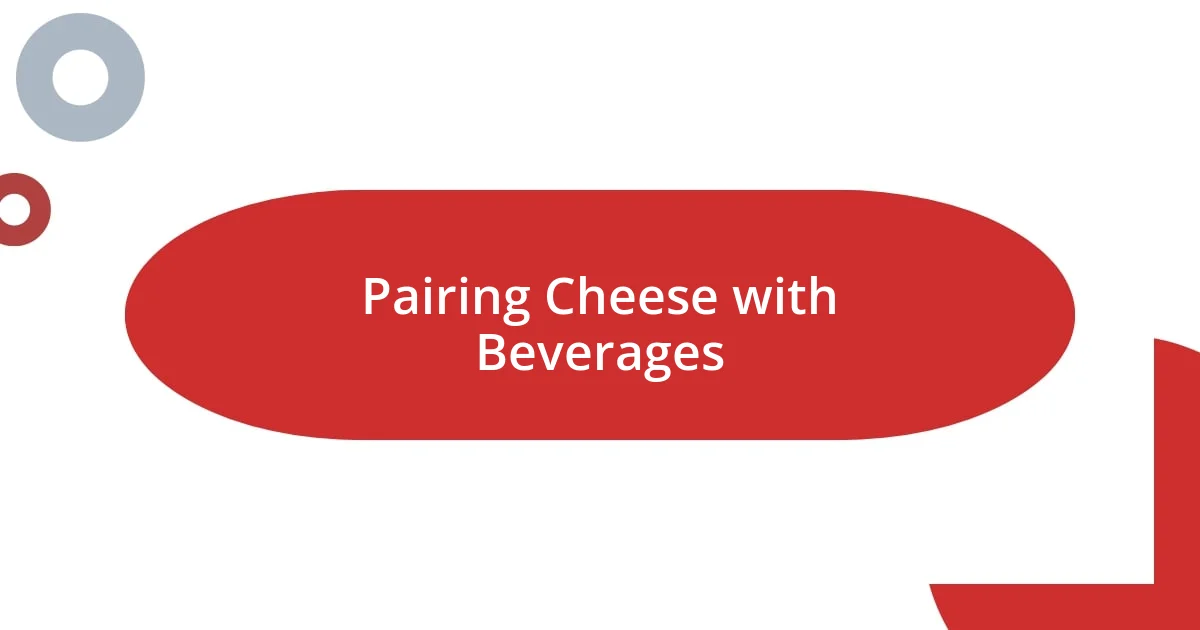
Pairing Cheese with Beverages
Pairing cheese with beverages can transform your entire dining experience. Personally, I’ve discovered that a crisp, chilled Sauvignon Blanc works wonders with a tangy goat cheese. The bright acidity cuts through the creaminess beautifully, leaving the palate refreshed. I vividly remember a summer picnic where this pairing made the whole afternoon feel vibrant and light, laughter echoing with each sip and bite.
On the other hand, rich cheeses, like an aged Gouda, pair splendidly with full-bodied red wines, such as a Cabernet Sauvignon. I learned this when I indulged in a sumptuous cheese board over an intimate dinner party. The wine’s tannins highlighted the cheese’s complexities, enhancing the flavors in unexpected ways. It felt like the cheese and wine had a conversation of their own, each sip deepening the experience.
Craft beers can also be a fun alternative when you’re feeling adventurous. I still recall pairing a nutty Havarti with a local amber ale; the maltiness complemented the cheese’s flavor remarkably well. This unexpected combination sparked delightful discussions about beer styles and cheese varieties, proving that sometimes, the best discoveries come from stepping outside the usual pairings.
| Creamy Brie | Chardonnay |
|---|---|
| Aged Gouda | Cabernet Sauvignon |
| Blue Cheese | Pale Ale |
| Goat Cheese | Sauvignon Blanc |
| Sharp Cheddar | Merlot |

Creating a Tasting Menu
Creating a tasting menu is where the creative magic truly happens. I remember my first attempt at a cheese tasting dinner; I structured it like a mini-journey through different flavors and textures. I placed a soft, creamy Brie first, allowing everyone to start with something familiar and comforting. The way it melted on the palate felt like a warm embrace, setting a cozy tone for the evening.
After that, I introduced a tangy goat cheese that kicked things up a notch. I can’t tell you how much I enjoyed watching my guests react to it—their faces lit up with surprise and delight! This transition into bolder flavors sparked conversations, laughter, and a sense of adventure around the table. Isn’t it fascinating how a simple piece of cheese can create a rich experience filled with connections?
To round off the tasting, I often include something unique, like a blue cheese with its strong, pungent character. It challenges the palate, and I love to hear my friends’ opinions as they navigate through its complexity. Does it evoke cherished memories or spark a new love affair for one of them? This part of the evening feels like a delightful experiment, and it’s moments like these that turn a simple meal into an unforgettable celebration of cheese.
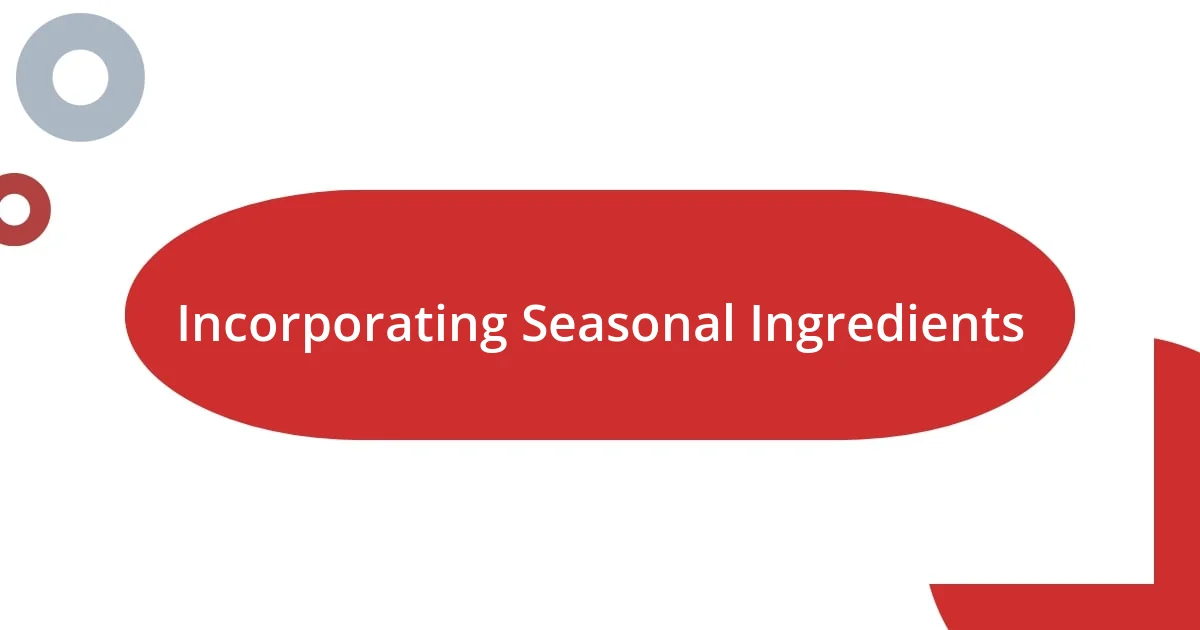
Incorporating Seasonal Ingredients
In my experience, incorporating seasonal ingredients into cheese-themed dinners adds a vibrant touch that truly elevates the meal. Last fall, I crafted a charcuterie board featuring sharp cheddar paired with candied pumpkin seeds. The sweetness of those seeds complemented the cheese’s richness so well that it sparked a conversation among my guests about the beauty of seasonal flavors. Can you imagine how a single seasonal ingredient can transform the entire dining dynamic?
I often find myself wandering through farmers’ markets to discover local produce that can enhance my cheese pairings. One summer, I stumbled upon heirloom tomatoes bursting with flavor, and I decided to create a refreshing salad to accompany a creamy burrata. The juicy tomatoes balanced the cheese’s richness perfectly, creating a dish that felt like a love letter to summer. It’s those serendipitous moments that remind me of the importance of using fresh, seasonal ingredients; they resonate with our senses and memories.
Don’t overlook the power of herbs and edible flowers, either! I remember infusing a soft goat cheese with fresh basil and edible lavender one evening. The aroma wafting through the air was so intoxicating that it drew everyone closer to the table, eager to sample something that looked as beautiful as it smelled. It got me thinking—how often do we let our ingredients shine not just through taste, but through visual appeal? Incorporating seasonal elements truly allows for magic to happen in the kitchen.
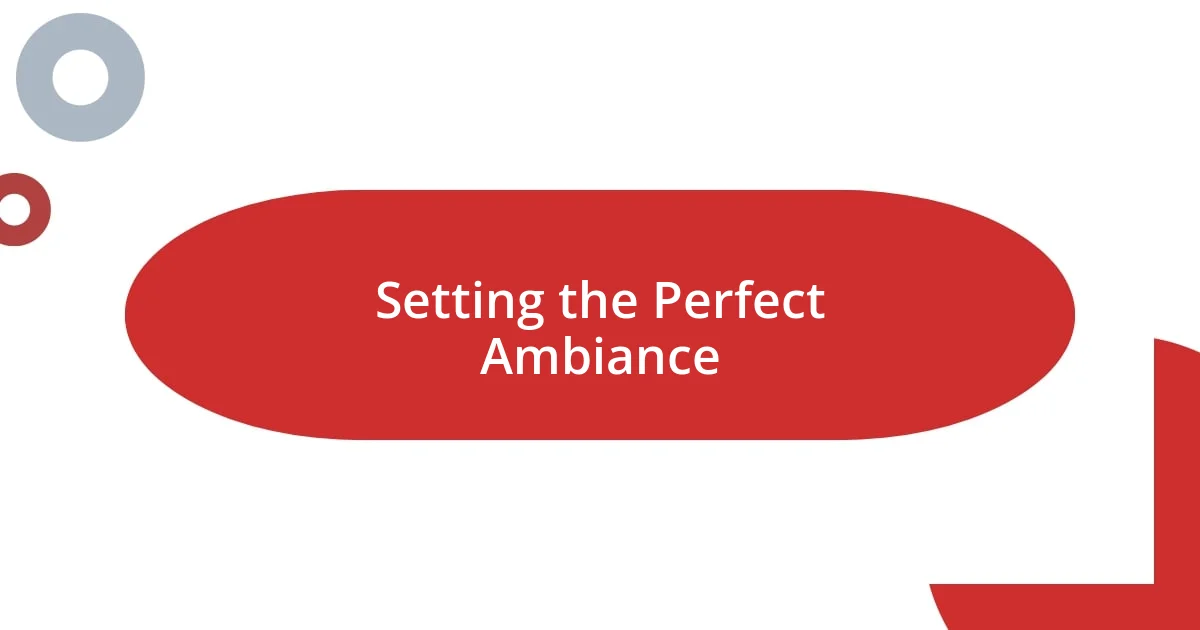
Setting the Perfect Ambiance
When it comes to setting the perfect ambiance for a cheese-themed dinner, lighting makes all the difference. I often dim the lights just enough to create a cozy glow, allowing the cheeses and other dishes to steal the show. Have you ever noticed how soft lighting can instantly make you feel more relaxed and inviting? It certainly sets the right tone for sharing stories and laughter around the table.
To elevate the experience even further, I love to scatter candles across the table. The flickering flames not only add warmth but also create an intimate atmosphere that encourages conversation. One memorable dinner, I used vintage candle holders, and their dim glow made the cheese platter shimmer like it was sprinkled with magic. It’s moments like that which linger in your mind long after the last bite. Why do you think ambiance impacts our dining experiences so profoundly? For me, it’s about establishing a connection—not just with the food, but with the people sharing it.
Finally, the power of music shouldn’t be underestimated. I carefully curate a playlist that complements the vibe of the evening. I remember a particular gathering where I matched a soft acoustic backdrop with our creamy cheeses, and it created such a relaxed and inviting space that my guests mentioned feeling like they were at a cozy bistro. Music, like cheese itself, can evoke emotions; it can take you somewhere special. How can you harness these elements in your next dinner to create an unforgettable experience?
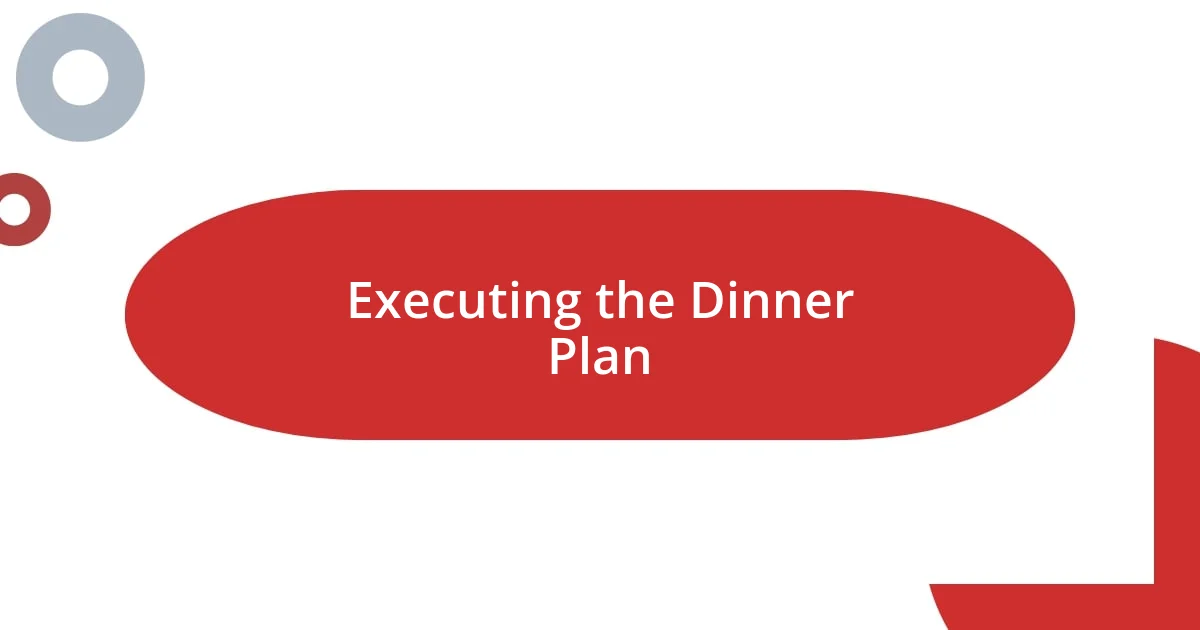
Executing the Dinner Plan
When it comes time to execute the dinner plan, I like to lay everything out ahead of time. Having all my selected cheeses and accompaniments organized allows me to flow seamlessly as the evening unfolds. Just the other day, I arranged a display of cheese, crackers, and fruits hours before guests arrived, which gave me the freedom to mingle and enjoy the atmosphere without feeling rushed. It’s such a game changer to start with a clear workspace, don’t you think?
I also try to prepare dishes that can be assembled quickly during the dinner. A few weeks ago, I whipped up a simple cheese fondue that was not only easy to prepare but also an engaging experience for everyone. As guests gathered around the pot, dipping fresh bread into the creamy blend, I could sense the excitement in the air—it becomes a shared activity that sparks laughter and delight. It’s moments like that when you really see how food brings people together.
Lastly, I insist on keeping the flow of the dinner relaxed. I’ve learned that having a little flexibility is key; for instance, if a guest wants to linger over a course, that’s perfectly fine with me. I recall an evening where we ended up chatting well past dessert, and instead of feeling pressured to keep things moving, I embraced the spontaneity. Who says dinner has to be structured? Sometimes, the best memories come from those delightful detours.

